HSP HISTORY Blog |
Interesting Frederick, Maryland tidbits and musings .
|
|
So I panicked the other night, while in the produce section of a grocery store. I was given a short list of items in the morning, and forgot one of five simple things I was supposed to come home with after work. I immediately went to my modern day “life-line” and security blanket in the form of an Apple I-Phone. I placed a call to my wife, knowing that I’d get a bit of playful razzing, but my short-term memory loss here should not be cause for a dinner mishap. Heaven forbid, I did not like the remote chance for a forced return to the market. Unfortunately, the phone just rang several times and went to voicemail. I tried again to no avail. I then called the archaic, and seldom used/answered, home phone line. Instant success came as my stepson Jack actually answered. Unfortunately, my wife had taken the other boys to a baseball practice, and inadvertently left her phone on the kitchen counter in her haste. I desperately hoped Jack could provide guidance, but this was a pipe dream as I caught him at a time of video game-induced coma by something called League of Legends. He could barely remember who I was, let alone grocery items of survival required for the household. As I hung up, I caught myself aimlessly staring at a bountiful stack of organic broccoli in front of me, and silently thought to myself, "I’m screwed.” Oh, the power and wizardry of smart phones—one of the most amazing inventions in my lifetime. Where would we be without them? How could we function at all? And this, coming from a guy who thought cordless household phones were God’s gift to mankind in the early 1990s. Actually, I take that back, I was quite impressed with earlier technological advancement in telephony with the advent of "call-waiting" and, best of all, the coiled phone cord extension of 30+ feet. This simple upgrade guaranteed a perpetual “cocoon of privacy,” a vast difference from the traditional norm of being tethered within a five-foot radius of the hard-mounted wall phone of my childhood. You could actually travel to a spot "two rooms away." This was especially helpful in the early forays of talking to girls while under the surveillance of parents, and worse yet, being under siege from two younger brothers whose intent was humiliation through catcalling and mimicry. The only downside of the 30+ phone cord extension was the accidental “clotheslining” of a hapless, elderly relative with cataract issues—but that's another story for another time.  Alexander Graham Bell and wife Mabel (the original "Ma Bell") Alexander Graham Bell and wife Mabel (the original "Ma Bell") Speaking of other times, and phones, I found out recently that Frederick, Maryland once hosted the original inventor of the telephone as a tourist for a weekend. Alexander Graham Bell and his wife Mabel took in our ample historic sites and recreated in the beautiful surrounding countryside, all while staying in one of the many downtown Frederick hotels of the period—the City Hotel. The brief weekend stay occurred just over 101 years ago, in late April 1915. Simultaneously, a “World War” was occurring over in Europe at the time, and America was contemplating a potential jump into the fray. It had been 29 years since Mr. Bell, a native of Scotland, had made his own impact on both national, and international levels. He was at the forefront of the revolutionary change in communications, thanks to a landmark demonstration in which he would “place a call” on March 10, 1876 to assistant Thomas Watson in Boston. Bell first successfully transmitted speech, saying "Mr. Watson, come here! I want to see you!" using a liquid transmitter. This was the first successful demonstration of what we would come to know (and love) as the telephone. Five months later (August 10, 1876), Alexander Graham Bell made the world's first long distance telephone call, about 6 miles, between Brantford and Paris, Ontario, Canada.
 Alexander Graham Bell teaching a deaf student Alexander Graham Bell teaching a deaf student Mr. and Mrs. Bell departed Frederick in their automobile on Sunday evening (April 25, 1915). Although not mentioned, I assume that another structure of interest to them must have been the Maryland School for the Deaf. And this would not be simply for the sake of history, as countless visitors have been impressed with the important past roles played by Frederick's historic "Hessian Barracks." No, I would think the Bells would have admired the school itself, with its grand façade and canopied turrets. More importantly, the important work being performed here by Maryland educators was what would have been most important to the tourist couple. You see, Alexander Graham Bell had started his working career in deaf education, and his inventive spirit was more rooted in helping those who couldn’t hear, than assisting those who could (as he did with the telephone). This came honestly as Bell’s mother was deaf, along with his Alexander's beloved wife Mabel, the latter having been deaf since infancy and a terrible bout with Scarlet Fever. Over the next forty years since Alexander Bell's visit to our town, Frederick continued to retain its hometown, rural charm, although a new wave of residents had come from around the country due to events tied to a Second World War in the 1940’s. Many of these people were bright scientists and pioneering inventors like Mr. Bell. They had come to study and experiment within the field of biological warfare at Fort Detrick. Life-long residents ingratiated the new-comers, and could sense that a major change was coming to the sleepy little town of “clustered spires, green walled by the hills of Maryland.” Another first for Frederick took place on June 6, 1954. This event didn’t bring the same fanfare associated with Alexander Graham Bell’s 1915 visit, or the excitement "voiced" in 1876 with the invention of the telephone—but no one can deny that this day would certainly “relate” on more levels than anyone could have possibly known at the outset.  Front page story on Frederick's first phone booth in the Frederick News (June 8, 1954) Front page story on Frederick's first phone booth in the Frederick News (June 8, 1954) The C&P Telephone Company sponsored a special event at the junction of US routes 40, 240 and 340, where they had freshly installed Frederick’s first telephone booth. The location was specifically chosen to assist motorists in being able to stop their travels and “phone home” in style. To inaugurate this new service and "christen the dial," company manager Walter Lanius would hail down one lucky motorist and give them the opportunity to call anyone, anywhere in the US on the phone company’s dime. A man was stopped at the light here and flagged down by Mr. Lanius, however he became suspicious, thinking the event was a rouse. He stepped on the gas and sped off, disappointing the throng of spectators and media gathered for this event. Mr. Lanius went back to finding his contestant. The second recipient of his offer was a finely dressed woman en-route to Mercersburg, PA (from Washington, DC) to pick up her children from a private school for the summer break. After listening to the offer, she immediately accepted being delighted to be asked. The lucky lady revealed that she was Carol Grosvenor Myers, wife of a prominent Washington physician. Her pedigree doesn’t stop there as her father was Gilbert H. Grosvenor, longtime president of the National Geographic Society and editor of its prestigious magazine. As if this wasn’t enough, her mother was Elsie May Bell Grosvenor, a daughter of Alexander Graham Bell! The stunned crowd would watch Mrs. Myers, the legendary inventor’s granddaughter, place her call to an aunt living in Miami, Florida. The recipient of the first phone call from Frederick’s first pay phone (and phone booth) would be Mrs. David Fairchild, aka Marian Bell—youngest daughter of Alexander Graham Bell. After that story, I'm sure you would be willing to believe the forgotten item on my grocery list. That would be bell peppers, needed for making Italian sausage sandwiches. History Shark Productions presents: Chris Haugh's "Frederick History 101" Are you interested in Frederick history? Want to learn more, and from this author?
Check out his latest, in-person and online course offering including Chris Haugh's "Frederick History 101" and "Up From the Meadows: The Class." Future offerings will include a 201 level class, special cemetery tours, and the American Civil War. Classes take place at Mount Olivet Cemetery's Key Chapel. For more info and course registration, click the button below! (More courses to come)
2 Comments
In last week’s blog, we covered a few novel firsts for Frederick—incandescent street lights and the first traffic stoplight, located at the Square Corner. While putting that piece together, I couldn’t help but think of Frederick’s many other firsts, but more so, I thought of famous inventors, and whether they visited town this fair city or not? While some indeed did, I found that we have special relationships to others which I will explore over the next few weeks. For starters, I looked only a few blocks away (from the Square Corner) to our famed and beloved “95-year-old, girl next door—Barbara Fritchie. I can hear an echo from the past say: “Drive if you must this old Model T, but spare your family’s horse,” he said. Could this have been uttered in jest by Henry Ford, the legendary industrialist and founder of the Ford Motor Company? I highly doubt it, but there is certainly a connection between the automobile mastermind and our Frederick Civil War heroine. Mr. Ford was born in the same year (1863)John Greenleaf Whittier wrote the "Ballad of Barbara Frietchie." Just over seventy years later, in the mid 1930's, he would send employees to Frederick to take detailed notes and measurements of the famed Barbara Fritchie House located on West Patrick Street adjacent Carroll Creek.  1937 period view of bedroom within Barbara Fritchie Cottage at the Dearborn Inn (courtesy of Henry Ford Collection) 1937 period view of bedroom within Barbara Fritchie Cottage at the Dearborn Inn (courtesy of Henry Ford Collection) The Dearborn Inn, located in Dearborn, Michigan, was built in 1931 by Henry Ford to serve passengers arriving and departing from the automobile pioneer’s aptly named Ford Airport. Sitting directly across the street from the aviation hub, Ford’s 179-room Dearborn Inn was the country’s first “airport hotel.” In 1937 the Colonial-themed Inn's accommodations were expanded to include guest cottages— replicas of homes of noted Americans. Designed by architect Charles Hart of the Treadway Inns Company of New York City, meticulous records were gathered at actual historic locations. Five dwellings would be arranged in a village-like setting behind the main hotel. Today, the faux hamlet still contains these buildings, revolutionary statesmen Patrick Henry, writers Edgar Allan Poe and Walt Whitman, Oliver Wolcott, and alas, former Frederick resident and star of John Greenleaf Whittier’s poem –Barbara Fritchie. The Dearborn Inn and adjacent guest replica homes still exist in their suburban Detroit setting, reflections of Henry Ford's admiration for American history. His ideal expanded to include the reconstruction and acquisition of several other important “heritage” buildings to form nearby Greenfield Village, part of the larger Henry Ford Museum— touted as the largest indoor-outdoor collection of our nation’s history.  Antique key fob for Dearborn's Barbara Fritchie House (now owned by the author, thanks to eBay!) Antique key fob for Dearborn's Barbara Fritchie House (now owned by the author, thanks to eBay!) Today, the Dearborn Inn, with its “colonial village,” is listed on both state and national historic home registers, while being managed by the Marriott Corporation. Located in close proximity to the Henry Ford Museum, the Inn not only offers a more traditional hotel experience, but for $200+/night, one can still stay in the Barbara Fritchie house. Hotel guests and other visitors to this unique Michigan attraction have the chance to learn the romantic tale of Ms. Fritchie and her dramatic defiance of September 1862. The hotel’s brochure offers a short biography and picture of Dame Fritchie, while guests have the opportunity for further exploration through reading the 30-stanza poem written by legendary New England poet, and abolitionist, John Greenleaf Whittier. This is quite helpful because to most of Dearborn’s tourists, particularly younger generations, Barbara Fritchie is certainly not a known quantity. But then again, how many of us can rattle off the many-splendored accomplishments of Oliver Wolcott?—You know, the 19th governor of Connecticut, and Signer of the Declaration of independence? If nothing else, he had a son named Frederick, and was a signer of the Articles of Confederation, a connection to another local hero named John Hanson. “Up From the Meadows rich with cars.” Since Mr. Ford embraced Frederick in Dearborn, it’s safe to say that we paid homage back to our country’s most famous automobile inventor. This came in the form of the Barbara Fritchie Tourist Cabins, once located at 230 West Patrick Street. Formerly known as The Tourists Park, a rustic campground established by the Maryland State Roads Commission to aid vehicular-based travelers, ground was broken in 1933 for a more sophisticated (relatively speaking) gas station and cabin compound—the creation of George S. Crawford of McKeesport, PA. Crawford’s brother-in-law, Charles A. Faust, actually managed the enclave of 26 bungalows which featured accommodations ranging from “DeLuxe, Twin, and Singles.” These were “Steam Heated” and boasted “Private Showers.” And if that’s not enough to entice the weary tourist, the site came with 24-hour service, and nightly lodging that costs from $1.50-$5.00. The Fritchie Cabin operation would last for half a century. It was sold at auction in 1987, “making way” for the mental health facility known as the Way Station, Inc.
May and June of 1888 was an "enlightening" time in Frederick City, both literally and figuratively. Crews of workman were busily planting poles and stringing wire for a system of incandescent lights throughout the city. These were being placed at 60 designated spots which included most major and secondary street, along with alley intersections. Lights were also installed at prime public use locations such as City Hall, the Frederick Jail, the baseball grounds (Frederick Fairgrounds), the Black Horse Tavern and the Pennsylvania Rail Road Station. Gas lighting had been installed in town nearly forty years prior around 1850. The Gas Works was located to the east of town, on East Church Street extended. This stretch of roadway, leading in and out of town, would fittingly take the moniker of Gas House Pike. In 1887, the municipality turned to the new innovation of modern electric lighting. The contract for this project was awarded to the New York Electric Construction Company out of New York City. At a cost of $17,000, a municipal light plant was soon built, having a capacity to illuminate 76 lamps.  First block of West Patrick Street, looking west (ca. 1916) First block of West Patrick Street, looking west (ca. 1916) This was just the start. Within two years, the Frederick Electric Light and Power Company came into being. $30,000 was the price tag for a plant would boast a 2,500 lamp capacity. Homes, stores, and factories of town could now be provided with light, heat and power. By the end of the decade (and century), electricity would give birth to a new mode of transportation that would revolutionize Frederick. This was a trolley system that would eventually link Frederick to Middletown and Hagerstown to the west, and in time, Thurmont to the north. Not only was this innovation a boon for passenger transport, it greatly aided in the movement of farm goods to market, and commercial delivery. Braddock Heights, a concoction of the new electric rail line and its parent company, would arise as a result. As the trolley made its debut in Frederick, so did the first automobiles. The streets of town now became extremely more dangerous, and at an exponential rate. Trolleys ran in the middle of principal roadways such as Market and Patrick streets. To each side was the right of way for motor cars, and the age-old transportation modes involving natural horsepower—vehicles such as carriages and wagons pulled by horses. It didn’t take long to employ the need for some sort of traffic control at the major intersections. The busiest location of all was the town’s central square at the junction of Market and Patrick streets, better known by the name Square Corner. As travel modes had improved and traffic grew, Frederick lost the opportunities once connected to having the Square Corner serve as an occasional social center of activity and events as was the case with small towns sprinkled throughout the county. It, however, remained as a busy pedestrian crossing point. A police officer would be positioned here to help keep law and order over traffic of the bipedal and vehicular kind.  Early traffic signal in Cleveland, Ohio. Early traffic signal in Cleveland, Ohio. In 1924, a newfangled invention would be added to the Square Corner, one the likes had never been seen before. This was a multi-colored light, which had a much greater purpose than the simplistic overhead light which had been installed in this locale some 36 years earlier. This was not a spotlight, it was an enforcer. Frederick, Maryland, would meet its first traffic light! - As another 36 years came and went, so did the interurban trolley system. Market Street would become one-way northbound, however Patrick Street would remain a two-way travel thoroughfare. This embodiment of the National Pike through Frederick City still served as the main route east and west through Maryland, and was as busy as ever in this era predating superhighways. At a time before Interstate70, not to mention US15 as a viable "north-south" bypass of downtown, the traffic light(s) at this location would lay witness to thousands of residents passing through Frederick’s central apex. This would hold true for an equal number of "out of town" visitors either heading to the legendary Francis Scott Key Hotel, one block to the west, or simply traveling through. Among these were key tourists of note, even United States presidents. We know with certainty the list included Herbert Hoover, Franklin D. Roosevelt, Harry Truman, and Dwight D. Eisenhower. John F. Kennedy can be put on the list as well, as he was driven through Frederick’s Square Corner as a US senator while on the presidential campaign trail. He spent a whirlwind three hours in town on May 13th, 1960. History Shark Productions presents: Chris Haugh's "Frederick History 101" Are you interested in Frederick history? Want to learn more, and from this author?
Check out his latest, in-person, course offering: Chris Haugh's "Frederick History 101," with the inaugural session scheduled as a 4-part/week course on Monday evenings in June, 2023 (June 5, 12, 19, 26). These will take place from 6-8:30pm at Mount Olivet Cemetery's Key Chapel. Cost is $79 (includes 4 classes). For more info and course registration, click the button below! (More courses to come) In August of 2009, I had a work conference to attend in Denver, Colorado. I was working for the Tourism Council of Frederick County at the time, and one of my job tasks was to oversee a national scenic byway—this took the form of the Catoctin Mountain National Byway, aka US15. Today, this stretch of roadway through Frederick County is known as Maryland’s portion of the Journey Through Hallowed Ground National Scenic Byway. Denver was the scene for the 2009 National Scenic Byways Conference, a biannual event that hosted tourism and transportation planning professionals from designated national scenic byways from around country: A1A in Florida, the Santa Fe Trail, Route 66, Skyline Drive, Merritt parkway, etc. having never been to Colorado before, and was excited with the planned itinerary for the week, and even took the opportunity to head out a few days early to do some extra sightseeing. Upon landing at Denver International Airport, I grabbed my rental car and headed immediately to Golden, Colorado. This tourist town was very welcoming, as most everything revolved around its top export—Coors beer. I happily succumbed to the Coors Brewery Tour, and then made my way onto the Lariat Loop route, a Colorado byway, which took me to my next destination atop Lookout Mountain. Once used by the Ute Indian tribe as a “lookout,” the attraction afforded me with incredible vistas of Great Plains as well as Golden below and Denver some 12 miles to the east. This foothill outlier of the legendary Rockies seemed about the same height as my hometown Catoctin Mountain back home with and its highest elevation of nearly 2000 feet above sea level. However, I was quickly reminded that the Denver vicinity already has the leg up on us as it’s not called the “Mile High City” for nothing.” The additional 5,280 feet combined with a like 2,000 giving it a total elevation of 7,377 feet above sea level.  The summit of Lookout Mountain is most famous for an unnatural feature—the gravesite of William F. "Buffalo Bill" Cody (February 26, 1846 – January 10, 1917), listed on the National Register of Historic Places. Cody experienced the Old West to its fullest extent. His skill as a buffalo hunter gained him the nickname "Buffalo Bill." He later became one of the greatest showmen in American history as his legendary Wild West shows traveled the world leaving a lasting vision of the American West. The Museum illustrates the life, times, and legend of William F. Cody. It includes exhibits about Buffalo Bill's life and the Wild West shows, Indian artifacts and firearms. See Sitting Bull's bow and arrows, Buffalo Bill's show outfits, Frederick Remington's "Portrait of a Ranch Hand," and many other objects from the Old West in the Buffalo Bill Museum and Grave. Buffalo Bill died in early 1917 and would be placed in a deep shaft carved out of the mountain summit. There were definite security concerns involving the deceased frontiersman because many friends from Cody, Wyoming vehemently claimed he should be buried there in the town he helped found. Thousands were on hand for his funeral in June.  Louisa Cody, who had married Buffalo Bill back before he became famous, was buried next to her husband four years later. That year, 1921, the Buffalo Bill Memorial Museum was begun by Johnny Baker. Baker was a close friend and more so, the unofficial foster son to Buffalo Bill. Although his parents never allowed Cody to officially adopt him, he nevertheless travelled, worked and studied with Buffalo Bill from the age of 7 years, after the death of Cody's natural son, Kit Carson, in 1876 at the age of 5. Under Cody's tutelage, young Johnny Baker became the sharpshooter star of "Buffalo Bill's Wild West" show in the United States and Europe, and later served as manager and worldwide booking agent for the show until Cody's passing. Just as millions of people saw Buffalo Bill in his Wild West shows during his lifetime, millions of persons have visited Buffalo Bill’s grave in the years since 1917. Today it is one of the top visitor attractions in Denver and Colorado. And I would follow suit on the late afternoon of August 22, 2009. The Museum chronicles the life, times, and legend of William F. Cody and includes exhibits about Buffalo Bill's life and the Wild West shows, Indian artifacts and firearms. In the collection, I also saw Sitting Bull's bow and arrows, Buffalo Bill's show outfits, Frederick Remington's "Portrait of a Ranch Hand," and many other objects from the Old West period of our history. However, among the many things I learned that day, there were actually two that stood above the rest. William F. Cody’s middle name was none other than Frederick! This was quite a happenstance, but I would find a deeper connection to home. In one of the galleries, I found a three-ring binder with an adjacent sign that read: Did Buffalo Bill Visit Your Town? This immediately captivated my attention, as I began to search for the Maryland section. Alas, I found that Buffalo Bill did visit Frederick, Maryland—October 2, 1916. Along with nearly 20 visits to Baltimore, a few to Cumberland, and one to Hagerstown (September 13, 1907), I felt an instant bond and was so glad I took the time to search this binder. I wrote down the date and stuck in my wallet, vowing to look for anything in the local papers at the Maryland Room (C. Burr Artz Library) when I returned back home after the conference.  I found advance notice of Buffalo Bill’s visit in mid-September. In those days, entertainment opportunities like today’s concerts and sporting events did not usually have the several-month waiting period we know today. Advance teams contacted newspaper offices, affixed broadside advertisement posters and “barked” in the streets in the days leading up to the “big event.” This was the case with Cody’s visit in the fall of 1916. It’s not only amazing to try to imagine the spectacle of seeing Cody and the show itself which often starred cowboys, Indians, Mexican peoples, but this was the magical and raw spirit of the far-off western frontier being brought to your sleepy hometown. And Frederick, unlike its own wild-west period of the 1740’s, was a tamed city of just under 11,000 inhabitants (ca 1916). The trains brought the performers and their animals into town. The B&O train station was positioned at the intersection of South Market and All Saints streets. The Pennsylvania Railroad Station was near the intersection of East Patrick and East streets. From these locations, circus parades would form as the onlookers lining Frederick’s principal streets were given a glimpse of what was to come. Usually these went up Market to the fountain at 7th Street, back down and along Patrick or Church streets to exhibition grounds along either street. Best of all, boys of all ages had their chance this time around to gaze at Buffalo Bill, the larger than life American hero and his several co-stars as they winded their way up Market Street and over to East Patrick Street. This particular show was not held at the Frederick Fairgrounds, but nearby at a place called Schildknecht Grounds thought to be on the east side of the intersection of East 7th Street and East Street.  Frederick Daily News (May 28, 1886) Frederick Daily News (May 28, 1886) Interestingly, this would be Buffalo Bill’s last ride and show in Maryland. He died just three short months later at the age of 70. Now in doing some additional research, I found an earlier visit to our fair town by William F. Cody. He performed here in 1894. The show was entitled "The Great Wild West" and was held at the Frederick Fairgrounds. An article pertaining to the latter 1916 visit claimed that Buffalo Bill was well-acquainted with our town, having used it earlier as a wintering quarters for his traveling show. I haven’t been able to “round up” any information to prove this statement, but am hoping somebody will “rustle up” something, someday. A few years back, I found that Buffalo Bill’s good friend Gordon Lillie had performed at the Great Frederick Fair a couple of times. Lillie went by his stage name of Pawnee Bill and brought to town his Pawnee Bill’s Historic Wild West Show. Mr. Lillie’s wife May starred in the show as the “Champion Girl Horseback Shot of the West.” His first show was here in 1888, but more would follow in subsequent years and by 1896 the show had grown to be named Pawnee Bill's Historic Wild West & Mexican Hippodrome. Buffalo Bill’s unofficial foster son Johnny Baker put on a shooting display here in Frederick in 18XX. As I noted earlier, Baker would go on to become a big star on his own and would eventually found the Buffalo Bill Museum, high atop Lookout Mountain. 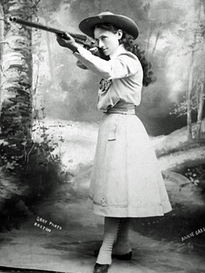 Annie Oakley Annie Oakley Annie Oakley, the “peerless rifle and wing shooter,” and former staple of many of Buffalo Bill’s shows, came to Frederick as well. The renowned international star visited here with The Young Buffalo Wild Best, Vernon C. Seaver’s Hippodrome and Col. Cummin’s Far East . This “circus” spectacular occurred in Freed’s Field (near the Fairgrounds) on August 22, 1913. Oakley was reported to have first visited Frederick nearly twenty years earlier while under the employ of Buffalo Bill. She would go on to reach legendary pop culture status for later generations as her life became the subject of stage and screen projects after her death in 1926.  Annie Oakley would make a posthumous return to town, just over two decades from her last. She would grace the silver screen (noted as being the only “silvertone” one in town at the time) of the Frederick Theater, located on N. Market Street (today the site of Starbuck’s Coffee House). The film, aptly named Annie Oakley, starred actress Barbara Stanwyck in the title role. Interestingly, Stanwyck (1907-1990) had started as a “Ziegfeld (Follies) Girl” and had a short, but notable, career as a stage actress in the late 1920s. She would go on to make 85 films in 38 years in Hollywood, before turning to television. Originally born Ruby Catherine Stevens, Stanwyck was urged to take on a stage name. She supposedly received inspiration while viewing a thirty year-old paper program or poster featuring a British actress named Jane Stanwyck who was then starring in playwright Clyde Fitch’s stage production of Barbara Frietchie, based on Frederick’s Civil War heroine. Ruby borrowed the Stanwyck from the star of the play, and Barbara from the “star” of our town. It was nearly 40 years ago, but I remember those events like it was only yesterday. Ah, yes—the two times I ever got in trouble in school. Both were elementary school infractions, once in second grade, the other in third. In each situation, I was caught laughing at a classmate’s funny comment, told to me while our teacher was in the midst of instructing. I straightened up and flew right after that. The first incident was certainly understandable, as another student was flopping all over kids in our reading group. This incident sent me and a cohort to the office for an inquisition from our principal who asked us the age-old question: ”What was so funny?” We made it through unscathed, and best of all, without further implications such as a call home. The takeaway was more the “principle” of being sent to the principal, which was a scary situation–one I didn’t want to experience again. A year later, in math class, I found myself distracted and daydreaming from my teacher’s lesson. Not that this was an isolated event, as the subject of Math would always be an Achilles heel, never quite resonating with me—save for the fact that I am married to a high school math teacher. The day’s instruction centered on subtraction, but specifically on borrowing when taking larger numbers from lesser numbers. Today, this is known better as “regrouping.” Our teacher may have been gifted in Math, but apparently not in English as she could not pronounce the word “borrow” correctly. She repeatedly kept saying “borry,” as in “Since the 5 below is greater than the 2 above, you have to borry from the first (tens) column, which will make this a 12.” All was going fine until my friend Johann turned to me and whispered: “Chris, can I borry a pencil so I can write this down?” I tried my best to hold in the laughter, but a chuckle snuck out of me, and Johann as well. As these life situations usually play out, the room at that moment had gone immediately silent, thus amplifying our laughter, and hence, our impending punishment. Mrs. G. stopped teaching and proceeded slowly to the back of the class towards us, pointing at us defiantly with her ruler. She used this “ancient” tool of measurement as a pointer, in the same vein an orchestra conductor uses a baton. Instead of sending us to the office, she chose her own brand of vigilante justice for our unkind interruption and disrespect. We were directed to kneel on the cold, hard concrete floor. The surface was polished which made it even more difficult to keep balanced in Sears brand “Toughskin” denim jeans, which were the pantaloons of choice in 1977. We had to serve out our sentence for nearly 20 minutes until the end of class. Let me tell you, I was rehabilitated, and vowed never to disrespect another teacher again. I also never complained about having to kneel in (Catholic) Church from that time forward, appreciating the modern convenience of padded kneelers. The reason I share these school memories of "pride and punishment" is to introduce a local news story from October, 1894 which caught my eye. It’s quite shocking, yet entertaining at the same time in a strange way. Like so many things in the study of history, you have to look at certain events, actions and reactions in context with the times in which they occur. With no further adieu, I present this clipping from the Frederick Daily News, October 4, 1894 edition:  Adam Roser Adam Roser The "hunted" in this story was a 12 year-old named Clayton Warner. The "hunter," Professor Adam Roser, was born in 1851 in Adams County, Pennsylvania. Soon after, his family made its way to Frederick County and New Midway. He would receive his own early schooling here before embarking on a teaching career around the year 1876. Ironically, I found a reference to Roser in the December 13, 1903 edition of the Frederick Daily News in a weekly section called Local Logic: expressions of people picked up by diligent reporters. The following, written ten months prior to the “dinnertime debacle,” is a quote from Mr. Roser: One week earlier (December 7, 1893), Roser had taken charge of the North Market Street public school. He had previously been employed at the Libertytown School. His new school building was no picnic as it was described as having a dilapidated interior and was not much more than a barn. Conditions were so bad that Arbor Day exercises for 1895 would be canceled because the staff was so embarrassed by the conditions of the school. A new structure would be built on this location in 1896, and became the home of the Boys' High School. (This would later serve as an early home for Frederick Community College as well. Today, it is readying for a new usage as mixed-income workforce housing.)  Jeff Spicoli, a pizza, and Mr. Hand from "Fast Times at Ridgemont High." Jeff Spicoli, a pizza, and Mr. Hand from "Fast Times at Ridgemont High." Now before you jump all over Professor Roser for his unprofessionalism and obvious lapse in good judgment by “crossing the line,” I want you to think for a moment of the dealings between Mr. (Arnold) Hand and difficult student Jeff Spicoli, resident surfer/burnout/dude, in the 1982 cinema classic “Fast Times at Ridgemont High.” Mr. Hand practiced incredible patience with Spicoli when the latter tried to usurp “his" (Mr. Hand’s) time. Could there be an ounce of justification for Mr. Roser "losing his cool" back in 1894? Please keep this in mind and put yourself in Mr. Roser's "educator shoes" for a moment. I went in search of Clayton Warner and found that he made headlines in early March, 1903. Apparently Warner and a pal decided to burglarize some merchants in the early morning hours of Sunday, March 1, 1903, nine years after Roser accosted Warner at the dinner table. Clayton Warner would be duly arrested, and it appears his parents refused to post bail. As for Adam Roser, he had a storied, but apparently regretful, career in teaching. The educator remained a longtime resident of Woodsboro and vicinity, and taught in the public schools of the county for nearly fifty years, retiring in 1926. He died in 1934 at the age of 82. Mr. Roser is buried in Woodsboro's Mount Hope Cemetery with wife Eliza J. (Delaplaine) Roser. May they both rest in peace, especially from any lingering spirit in the form of little Clayton Warner. History Shark Productions presents: Chris Haugh's "Frederick History 101" Are you interested in Frederick history? Want to learn more from this author?
Check out his latest, in-person, course offering: Chris Haugh's "Frederick History 101," with the inaugural session scheduled as a 4-part/week course on Monday evenings in June, 2023 (June 5, 12, 19, 26). These will take place from 6-8:30pm at Mount Olivet Cemetery's Key Chapel. Cost is $79. For more info and course registration, click the button below! (More courses to come)  Newspaper announcement of the mall's grand opening. (Note how it exclaims: "A Galaxy of Fine Stores and Services.") Newspaper announcement of the mall's grand opening. (Note how it exclaims: "A Galaxy of Fine Stores and Services.") I certainly smiled the other day when I saw the Frederick News-Post article announcing the recent groundbreaking for the Frederick Towne Center project (aka the Frederick Towne Mall “Facelift”). I am truly excited to see the results of this new chapter in the history of this iconic Frederick landmark. I suddenly began to reminisce about fond times had in my youth with my late father and two younger brothers. This was the magical, weekly trip to the mall on Saturday afternoons. And not just any mall, but the Frederick Towne Mall complete with with the old school spelling of “towne,” or should I say “olde school?” The Frederick Towne Mall opened amidst great anticipation and fanfare in late summer of 1972. It was located amidst former sleepy farmland west of Frederick on West Patrick Street/ US40 West. This route would soon see rapid commercial development and soon earn the moniker of “the Golden Mile,” thanks to Millard "Mick" Mastrino, a Maryland State Police trooper who would eventually retire a sergeant with the Maryland State Police and president emeritus of United Steam-Fire Engine Co. The original owner and developer of this “Shopping Taj Mahal” was the Shopco Company of New York City (owned by Harold Yasky and Arnold Praver). It would eventually be sold years later to DeBartolo Development, under Edward J. DeBartolo of Youngstown, Ohio. Now the name may be familiar to 80’s fans because Edward J. DeBartolo bought a professional football franchise in 1977 as a gift for his son Edward J. DeBartolo, Jr. This was the San Francisco 49ers, winners of multiple NFL Super Bowl titles during the decade.  The 580,000 square foot structure included 73 stores in its heyday. It was anchored by major department stores: JC Penney’s to the west, and Montgomery Wards to the east. In the middle, was Eyerlys (later known by its full name of Bon-Ton Eyerlys). About 20 years ago, I found an original brochure from the Mall’s inaugural. It hadn’t traveled far since it was in a stack of local paper ephemera at the Wonder Book Store, located directly across the street from the once regal mall. The brochure proudly boasted that the Frederick Towne Mall was “…the most modern shopping center in the world—with the charm of Colonial America!” This was a pretty bold statement, but one that likely held truth since I didn’t remember anything quite like it when my parents dragged us down to Williamsburg during the 1976 Revolutionary War Bicentennial period. What did catch me off guard when perusing this brochure closer was the artist depiction of an indoor skating rink in front of J.C. Penney. I remember the open space, but never any ice or skaters. The true selling point of this Colonial themed consumer hub was free, easy-access parking that could accommodate 3,500 cars. At this time, a burgeoning Downtown Frederick sans parking garages was not convenient to shoppers who had to scramble for parking spaces, and feed meters. Now we may have no problem doing this today with a lunch or shopping jaunt in Downtown Frederick today (even with many parking decks at our disposal), but imagine having to find, and pay for, parking every time you have to go to any of the many box stores and “box restaurants” we have today? You can see the allure. It’s no wonder the heavily marketed catch slogan of this place would become “The Frederick Towne Mall…The talk of the town!” As I have dabbled in product development and marketing myself, I personally don’t think the message was as powerful and poignant as that of the later, greater Francis Scott Key Mall (aka “The New Mall”) which would one day proclaim “The Francis Scott Key Mall: We’ve got shopability!” But the Frederick Towne Mall was our first indoor shopping center, the original, the trendsetter, and possessed so much more charm and personality than FSK….at least in as much as a shopping center could do. 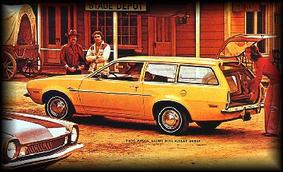 The “Old Mall” was a big player in the onetime death of downtown Frederick. The story was the same in many other places. The suburbs were booming both commercially and residentially. My family was part of it when we moved to the Indian Springs area northwest of Frederick City in spring 1974. Clover Hill 1 and West Hills were newfound oases, far from town, existing almost like the early Las Vegas of the 1931 when Nevada legalized gambling. There was no Old Farm, or Whittier developments— just wide open farm land. Our house off Stonehouse Road, at the foot of the mountain, was among the first of a beautiful little neighborhood to grow up in. Traffic free streets to ride bikes, and acre sized lots that gave good separation between next door neighbors, while allowing you to build backyard sports complexes if you chose. One of the nicest perks of our home location was that it offered a virtual backroads shortcut to the Frederick Towne Mall. Mapquest wasn’t on anyone’s radar back then, but one could get from Point A (our home) to Point B (the mall) by using a route that included Rocky Springs Road, Kemp Lane, (a quick 50 yards on) Shookstown Road and Waverly Drive. That was it, and we didn’t even have to get on the Golden Mile! Best of all, it only took about 8 minutes by use of our trusty, 1972, bright orange Ford Pinto station wagon. Every Saturday, my father would take me and my brothers Tim and Jon to the mall. The rationale was twofold as my Dad had to run errands yes, but this was also a chance to give my poor mother a respite from the constant fighting or heated sport/game competitions involving boys. The trip would always start with a lunch stop. The Minute Grill (which would evolve later into the Casa Rico restaurant) was my Dad’s favorite and it can best be described as a poor man’s Ponderosa Steak House. As a matter of fact, it had been a Ponderosa before. Oh, the magic of the times, one in which the western motif idealized in television shows of the 50’s and 60’s had now carried over into eating establishments like Arby’s and the Rustler. The sole survivor of this craze remains today and is one of Frederick’s own (literally and figuratively) Roy Rogers restaurant. And my Dad had us there at the grand opening when Roy Rogers and Dale Evans were on hand to open Frederick’s first of the fabled franchise on the Golden Mile, conveniently located directly across from the mall. As for the Minute Grill, it was always hamburgers and fries for us. However, the beverage portion of the meal was memorable as this was the important period in American history of the advent of the “all you can drink,” free refills. Something we would learn to regret week after week as we suffered from soda-induced stomach aches.  Frederick native and news reporter Virginia Cha (courtesy KGTV ABC10) Frederick native and news reporter Virginia Cha (courtesy KGTV ABC10) After lunch, we were soon heading across the parking lot to the mall. We were greeted by the delightful smells wafting from Pappy’s Pizza upon our official entry on the mall’s south west side. No offense to “the west end,” but the “meat and potatoes” end of the mall was on the east end, but not the far east side. And when I say “far east side,” I’m not talking about the east wing extension which included two Asian-American owned businesses: “Your Custom Tailor” and the “Real-Rich Ice Cream” establishment. The latter was owned by the Korean Cha family of town. A daughter, Virginia Cha, a Gov. Thomas Johnson High School grad is one of the most beautiful and talented women to grace the mall (and our fair county). She would hold the title of Miss Frederick, Miss Maryland and was runner up for the title of Miss America in 1990! The Princeton graduate has had quite a successful career as a news reporter and correspondent with stints throughout the country including CNN and HLN. Currently she is with KGTV ABC10 in San Diego.  The eastern end of the mall had our three favorite venues. For me, it was Waxie Maxies record store. Tim eagerly longed for the Time Out Arcade. My youngest brother spent an inordinate amount of time in Walden Book Store, but not by choice. This was my father’s favorite store, and since Jon was the runt, he had to accompany Dad as Tim and I got to do our own thing in our respective stores. This gave us our first real sense of freedom, as our dad left us unsupervised, and it didn’t hurt that all three establishments were next to each other in succession. I would spend hard-earned allowance money (garnered from cleaning our house) on records, particularly 45 rpm records. I spent a lot of time and money in that store, eventually collecting over 1000 45’s and hundreds of 33rpm vinyl albums—more relics from the past. Meanwhile, Tim was spending just as much, however he was doing so one quarter at a time. He was caught up in the Pac Man craze of 1980, followed by the darker Donkey Kong period of Arcadia. I didn’t get crazy over video arcade games, because I preferred sports games. Back then, these were pretty clunky and some featured running in the form of spinning a stationary duckpin bowling ball, which lived in a recessed cavity in the arcade game's tabletop framework. I was much more satisfied kicking my brother's butt at home in football and baseball as our family was one of the first to acquire the coveted Mattel Intellivision, the “best in show” of the gaming world in the early 80’s.  The McCrory's Lunch Counter and Cafe The McCrory's Lunch Counter and Cafe Any quarters I had in my pocket weren’t wasted on video games, They would be “wasted” on miniature NFL plastic football helmets hailing from a lone coin vending machine attributed to McCrory’s—the Darwin missing link to the Wal-Mart of today. It was also home to one of the most impressive mall snack bars in the nation. It was an amazing place where commerce and coleslaw collided for a down-home store-cooked meal. Can young people today even comprehend an eatery amidst a 5&10/drug store? For being patient in the bookstore, my youngest brother earned us a trip to KayBee toys, even if it was only a chance to simply window shop and play with toys within the confines of the store. KayBee was across from McCrory’s and next to another fine eatery, Friendly’s. Sometimes we’d get to eat at these establishments instead of the Minute Grill. Friendly’s was known for its colorful, sherbet inspired Fribble, while McCrorys had the best hot dogs, served on a grilled roll. And this was the same grilled roll that could be had at Friendly’s if you were in a seafarin’ mood, desiring the almighty Clamwich. Now that was fried goodness with an overwhelming “tang of the sea.” But why stop there, because true aficionados could make the trek to Long John Silvers, the only one of its kind in Frederick, for a bounty of fish planks and hush puppies.  The Center Court festival area featured mainstays like Radio Shack and the Earring Tree. Shipleys Sporting Goods was nearby and always captured our imagination. Moving in a westerly fashion from this locale was basically “Yawnsville” for our pack of young boys, save for the occasional chuckle when passing JoAnn’s Nut House, which would usually bring on a brief chastising by our father to mind our manners. The Hallmark Store, Hanover Shoes and Melart Jewelers elicited zero reaction. We couldn’t quite figure out what role Fashion Bug Plus would ever play in our lives either. There were other girls’ clothes and shoe stores too, all of which barely register any name recognition to me. JC Penneys stood proudly at the west end, and it was big fun to ride the escalators to the second floor. The tradeoff, of course, was having to suffer through our father perusing the latest offerings from the Kenny Rogers Collection, but that was a “gamble” that was well worth it because the upstairs had electronic gadgets, and was a showroom for us to bug our dad for upcoming Christmas presents. As we departed the mall’s biosphere by that southwest entrance and made our way back to the car, my brothers and I experienced that sad feeling that usually accompanies the end of a great vacation, holiday season or visit with long-distance relatives. This had been the high point of our respective week. Even harder to bear was the fact that we had to suffer through another six days until our triumphant return. Or maybe it was because we had the knowledge that we weren’t heading home just yet. We had to go to the grocery store for the weekly family shopping spree. And nothing for us was more unbearable, tedious and boring than going to the grocery store, something I still despise to this day. The Frederick Towne Mall was an important part of my childhood, and I look back fondly at the male bonding experience had with my father and brothers during those days. “The Old Mall” was definitely something more than a close-quartered haven of trade and commerce, or a joyful recreational shopping experience and endless buffet of fried seafood— It was a childhood friend. Thank you Frederick Towne Mall for the memories...you were certainly “The talk of the town!” back in your day. History Shark Productions presents:
Chris Haugh's "Frederick History 101" Are you interested in Frederick history? Want to learn more from this award-winning author and documentarian? Check out his latest, in-person, course offering: Chris Haugh's "Frederick History 101," with a 4-part/week course on Tuesday evenings in late August/early September, 2023 (Aug. 22, 29 & Sept 5, 12). These will take place from 6-8:30pm at Mount Olivet Cemetery's Key Chapel. Cost is $79 (includes 4 classes). In addition to the lecture class above, two unique "Frederick History 101 Walking Tour-Classes" in Mount Olivet Cemetery will be led by Chris in August focusing on interesting local, historical figures of the 1900s. These are available for different dates ( Aug. 8th and Aug 23rd) Cost $20. For more info and course registration, click the button below! Last week’s blog centered on the Culler Lake renovations, and how the water feature within Baker Park came into being. This week, I want to review some earlier Frederick parks, with emphasis on those located in the western and northwestern reaches of Frederick City. I also want to call out a “predecessor” and inspiration for Culler Lake, just a few short blocks to the north. Schley Park This oft overlooked gem was established in 1913 as part of the College Park residential development, originally built by the Swastika Realty Company. The area encompassed rolling farmland west of Rockwell Terrace, south of the newly opened Hood College. The small oasis featured a contest to pick its final name. One of two choices included Scott Key Park, of course named for Frederick’s favorite son, Francis Scott Key (he of Star-Spangled Banner fame). The other choice was Schley Park, a nod to another Frederick native Winfield Scott Schley, naval hero of the Battle of Santiago in the Spanish American War which had occurred in 1898. I’m guessing at the time, it was safe to say that the park would not get off “Scott” free (as in Scot free). The latter choice won at the ballot box, and it’s been Schley Park for more than a century. After a positive start, the park apparently became neglected. it would enjoy a Renaissance in 1920.  George E. Burnap (ca. 1914) George E. Burnap (ca. 1914) The park, and surrounding layout for housing development and street design was created by a renowned landscape architect George Elberton Burnap (1885-1938). The Cultural Landscape Foundation offers the following biography on Mr. Burnap: Born in Hopkinton, Massachusetts, Burnap studied architecture and landscape architecture at the Massachusetts Institute of Technology (MIT), Cornell, and, later, at the University of Paris. He served as landscape architect for the Office of Public Buildings and Grounds in Washington, D.C. and was involved in the design and redesign of many of the District’s most celebrated public spaces, including the Tidal Basin, with its flowering cherry trees, and both Montrose and Meridian Hill Parks. He also designed parks and park systems in Missouri, Nebraska, New York, Maryland, Virginia, and South Carolina. A lecturer on civic design at MIT, University of Pennsylvania, and University of Illinois, Burnap authored Parks: Their Design, Equipment, and Use in 1916. Burnap likely took the Frederick job in an effort to spend additional time with his sister Grace, who was working at Hood College at the time in the music department. Court Park This important swath of land has been an important meeting ground for over 270 years, dating back to the county’s founding in 1748. As the courthouse lawn, it once was surrounded by an iron fence, that is said to have helped corral pigs and other livestock. The citizenry begged for its removal in the around the turn of the 20th century, allowing for the public to enjoy the grounds more fully. Court Park has become is today more commonly as Court House Square (or Court Square). In 1919, much discussion revolved around the removal of the decorative iron fountain located in front of the Courthouse front steps. This was a gift from resident James C. Clarke, a longtime railroad executive and namesake of Clarke Place on the city’s south side. Some wanted the iron fountain moved so a World War I monument/memorial could be put in its place. A change of mind came about, and so did a parcel of property two blocks away on the northeast corner of 2nd and Bentz streets. This would become the home for the war monument entitled “Victory.” The space would earn the name Memorial Park. 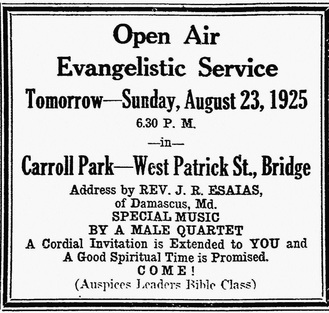 Carroll Park This was the original, “old school” portion of the Carroll Creek Linear Park. In 1907, Frederick alderman, and successful downtown merchant, David Lowenstein suggested putting a monument in the vicinity of where the Barbara Fritchie house had once stood. The legendary home had been partially destroyed in the Great Flood of 1868, and subsequently removed completely a short time later in an effort to widen the creek. Alderman Lowenstein went one step further by suggesting that a park be built on the west side of Carroll Creek surrounding Riehl’s Spring. This would become known as Carroll Park, a frequent scene of band concerts, camp meetings and unruly teenagers. Tourist Park Another park of note was located a few blocks west on West Patrick Street. This was the Tourists Park, an auto camp project of the Maryland State Roads Commission, and one of eight located on the National Road. Others existed in Elkridge, Cooksville, Conococheague, Hancock, Bellgrove, Frostburg and Negro Mountain. Supplied with all the conveniences a traveler may need, these places were practically small economy cabins in the same vein as the recently departed “Camp Cozy” in Thurmont. They were the forerunners of campgrounds (ala Jellystone Park) before the era of tow-able trailers and campers. Frederick’s tourist camp officially opened around 1922. This lasted for over a decade and would eventually become known by took the name of the Barbara Fritchie Motel and Tourist Cabins. John “Dutch” Faust from Pittsburgh operated this business for several years. Today this area is the home of the Way Station.  Reservoir (off W. 7th Street) as pictured in the 1873 Titus Atlas Reservoir (off W. 7th Street) as pictured in the 1873 Titus Atlas Reservoir Park An impressive municipal structure was completed in 1845—the City of Frederick’s reservoir works and grounds. Construction began in 1844 and the $90,000 project served as a better means to handle the growing town’s water needs. This municipal godsend replaced the former system of water connection stretching out to Catoctin Mountain, northwest of the city in the vicinity of Yellow Springs where wooden pipes carried water from an artesian well to a reservoir. The “new reservoir” was located at a place that would one day become the north end of Culler Avenue, just below West 7th street. The town “water-works” would be rebuilt in 1895 in the same location, but with a new capacity of 8 million gallons. An ornamental statue (of a woman with upraised cup in hand), was a hallmark at the reservoir. With the 1890’s renovation, the statue was converted into a showering fountain. When the 7th Street reservoir was rendered unnecessary due to advanced technology in municipal water supply, it became a recreational park. Today, you can still see remains of the reservoir’s retaining walls while visiting Max Kehne Park on West 7th Street. East Frederick Little League has their baseball field within the footprint of the old water source.  Pitching ace Max Kehne (ca.1947) Pitching ace Max Kehne (ca.1947) Fittingly, this park’s namesake, Max Kehne, was a standout ballplayer himself. His play as a youth gained him great accolades, and this would continue into adulthood. He was known best for his softball pitching. He was involved in leadership roles in a number of local activities including President of the Maryland Baseball Association and President of the Frederick Touchdown Club. After many years, Max Kehne entered politics and won election as a Frederick City Alderman in 1969. Sadly, Max Kehne died at age 45, the victim of a drunk driver on April 19th 1973, as he was traveling back to Frederick on I-70. Max Kehne Memorial Park was dedicated to this special man and athlete on May 22nd, 1977, four years after his death. His namesake park is adorned with a softball diamond as well.  I have had the good fortune of working for some great employers over the past 26 years. Best of all, I have spent my entire “working career” in the municipal boundaries of Frederick City. I am equally grateful for extremely limited commutes over the years, being one in the minority lucky enough to work within minutes of my home, which is conveniently located northwest of our historic downtown near Fort Detrick. Both my parents suffered through long daily commutes to their respective employers in Bethesda and Silver Spring (MD). In stark contrast, my drive to work is stress-free. Instead of taking US70 to Baltimore, or sitting in bumper to bumper traffic en-route to Washington (DC) via I-270, my drive occasionally takes me on “busy” thoroughfares such as Rosemont Ave, Market Street and the “expressway-esque” Bentz Street—at least in a southerly direction. Important landmarks that dot my way range from Schifferstadt, Baker Park , the Carroll Creek master conduit and that mystifying display window at the southwest corner of West Patrick and Bentz, always creatively decorated for the next major holiday. Instead of the Mormon Tabernacle off the 495 Beltway, I catch scenic glimpses of our famed “Clustered Spires.” Of course, this passage is not to rub it in, as I truly have empathy for the tens of thousands of my Frederick County brethren that have to make that hour plus sojourn twice a day. I sincerely salute all of you. But I do have to say that I have actually felt a fraction of your “commuting pain” from time to time. This downside stems from the occasional delay caused by waterfowl crossing against traffic on W. Second Street, adjacent Culler Lake. Speaking of this latter phenomenon later, my commutes of late have been “duck-free” due to the major renovation project going on at Culler Lake. However, I have been slowed in this vicinity just the same by my inherent desire to rubber-neck in an effort to see the progress on the lake efforts. It’s truly a changed landscape at present, and one that is sure to capture the imagination of Fredericktonians young and old. As for the park itself, it has quite an interesting history that dates back nearly 100 years. The whole plan started as a call was made for a memorial park to honor the local boys who sacrificed the lives for our freedoms in World War I. The former German Reformed Church burying ground, adjacent the junction of Bentz and W. Second Street, was secured. However, a much bigger parcel was desired, one that could provide recreational opportunities for city residents while holding the moniker of Memorial Park in the same vain as Frederick’s aptly named Memorial Hospital some years before. This became quite a big deal and controversial issue in the spring of 1920 as local businessmen, politicians and residents were split over the decision to go after state bonds to the tune of $50,000 to complete the park which was estimated to cost $90,000. The bond request was denied by the General Assembly, but the project creeped forward under private advancement. Enter Joseph Dill Baker and his wife, who purchased two pivotal farm properties west of Bentz Street and selflessly donated them to the cause. It’s interesting to see a connection to the Frederick of today, with the current political debate over funding for a Downtown Conference Center for Frederick. As this has the potential to be a slam-dunk plus for local tourism and business, such was the case with the creation of a municipal park nearly 100 years ago. The local newspapers of the 1920’s are riddled with advertisements and testimonials for Potts & Griffin’s “College Park,” the hottest residential endeavor to ever hit Frederick City. This was part of a major annexation northwest of “old downtown,” where a suburban residential oasis was being created west of Rockwell Terrace. More than a conference center's power to attract tourists to come to town and patronize local stores and residents, “the Northwest Addition” (as it was called) had the ability to permanently grow Frederick's population by attracting new residents to town. And how could the "new neighborhood" be any sweeter with the potential of promising buyers a beautiful park space in the near future, built smack dab in the midst of their residential development? Property values would (and did) soar, and everybody involved became a winner. It's no wonder the College Park Company corporation was composed of the brightest business minds in Frederick County.  Lloyd C. Culler (1869-1960) Lloyd C. Culler (1869-1960) Municipal Park, as it was originally called, officially opened on June 23, 1927 amidst tremendous fanfare. Within two month’s time, Frederick’s mayor would have the recreational area’s name changed to Baker Park in an effort to appropriately thank the pivotal benefactors—Mr. and Mrs. Baker. This was a gentleman named Lloyd C. Culler. Culler grew up in the Feagaville area and initially worked on the family farm before opening his own construction business which would become one of the busiest contract building firms in Frederick history. He was a close friend of Mr. Baker, and his company surely benefitted from this relationship for Baker was a powerful businessman, banker and philanthropic legend which gained him of the title: "Frederick's First Citizen." Culler also knew the ins and outs of politics, serving as mayor from 1922-31, and again from 1934-40. Mr. Baker’s Citizen’s National Bank would flourish as well thanks to the residential home loans “College Park” would bring. 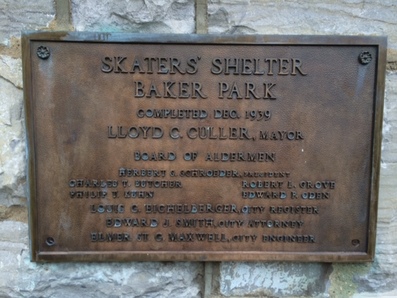 As I said, the new park was an inviting amenity for home buyers, just as it is today. And the addition of a controlled, passive water element in addition to the wily Carroll Creek was an added bonus. This took the form of a man-made lake, whose inspiration came from an existing pond used by the Kidwiler family who owned this parcel before it went to parkland and City. The Kidwilers used the pond for ice production in winter and raising goldfish in summer. Residents in the know had come here for ice skating for years. Now this location was going to provide recreation for all: ice skating in winter and boating/fishing in summer. Construction began in late fall of 1926 through the winter of 1927. A decade later, in the throes of the Great Depression, the Works Progress Administration was contracted to enlarge and deepen the Municipal Pond and stabilize its embankments. On January 7, 1940, the pond would be named Culler Lake in honor of the longtime mayor and dedicated public servant who along with Joseph D. Baker, made the park a reality. Coincidentally, the hard-working Chairman of the Municipal Park Project would also have his name memorialized, but not herein this park. This was local miller, outdoorsman and outspoken conservationist James H. Gambrill. His namesake park had been unveiled in 1934. Culler Lake has two trademark features: the Skater’s Shelter (commonly called the Boat House) and the fountain within. This week, you won't find the main ingredient of Culler Lake, that being H20. The water has been completely drained so construction crews can do their job which includes extensive dredging of the lake bottom and “shoring up” the shoreline. This is difficult, dirty work, as new landscaping elements and ornamentation will come later. As I snapped a few pictures the other morning, I marveled as a bulldozer almost appeared to be sucked into the mud and muck. I started thinking about the chemical composition of that lake bottom and quickly recalled the signs pleading visitors not to feed the ducks. Regardless, a fowl thought, and equally fowl part of this exciting renovation for those employees of Morgan-Keller, contractor for the project.  Vintage Z104 belt buckle (ca. 1982)from the author's personal collection Vintage Z104 belt buckle (ca. 1982)from the author's personal collection I couldn't help to flash back to my childhood and my most memorable times at Culler Lake. Although revived recently, the bathtub races of the early 80's were quite a hometown event. Radio station Z104 (aka WZYQ) was instigator and host to the annual revelry which included plenty of “Hit-Crankin', Hot Rockin’ music," and legendary deejay Kemosabi Joe (who I am proud to have as a FaceBook friend, and more so, was a childhood icon of mine turned real-life co-worker for my first ever job at Skatehaven Roller Rink (1984-85) as a deejay. In recent years, archeologists have found a myriad of artifacts on the grounds of Schifferstadt Architectural Museum. These represent an interesting cross section of Frederick City’s 270+ year history and beyond going back thousands of years with Native American finds such as spear points and pottery shards. I wonder if any of the Culler Lake construction crew will find a Kidwiler family heirloom, stray ice skate, or the hull of an ill-fated bathtub from yesteryear? At the very least a coveted Z104 belt buckle? One can only hope as they are all lost treasures of Frederick’s glorious past. Thanks to renovation projects like this, and those who have led the charge and others who have donated the funds to perform them, Frederick will have an equally glorious future. Those damn ducks better appreciate all the work that is being done to improve their glorious W. Second Street home.  Quartzite Quartzite Well it sure sounds pretty ominous, but let me assure you that our monadnock is sweet and lovable—actually “sugary sweet,” at least in name. And we certainly aren’t talking about a creature like Sasquatch, Chupacabra or even the Snallygaster. What we have is a geologic phenomenon, and not one of biological creation. To start the conversation, I want to point out that we have rocks in our area that were formed in the early Paleozoic period of the Cambrian era. This was roughly 500 million years ago and the result is a rock called Weverton Quartzite. Quartzite was originally pure quartz sandstone before the conversion process of metamorphosis which consisted of heating and pressure related by techtonic compression. Put more simply, this is the compacted form of sand, perhaps coming from the shoreline of ancient beaches first turned into sandstone and later into quartzite. The mountains of Frederick County were formed at a time when most of our vicinity was underwater. The uplifting could have been caused by the collision of plates such as ours with Africa. Our mountains, when they were “brand, spanking new,” are said to have been as high as the Himalayas, and multiple times higher than younger chains such as the Rockies. Our ancient Catoctin Mountain (and South Mountain) wore down over the next couple of million years thanks to erosive factors.  "Sunset Sugarloaf Mountain, Dickerson, MD" by artist Mimi Betz "Sunset Sugarloaf Mountain, Dickerson, MD" by artist Mimi Betz The most unique of our vicinity’s landforms, the picturesque Sugarloaf Mountain, is really not a mountain in the general sense. Rather it is better known as a monadnock. And what’s a monadnock you ask? A monadnock is a unique geologic creation of a landform resembling a mountain that remains after erosion of surrounding land, but not uplifting of the earth’s crust. These are isolated mountains in a general sense. Created the same time as the Blue Ridge mountains, geologists conclude that Sugarloaf Mountain represents the original elevation of the area around it, and took approximately 14 million years to form. This can be blamed in part on the quartzite cap at the summit which as highly resistant to erosional factors as opposed to the surrounding underlying limestone of Carrollton Manor. Just imagine the analogy of holding an umbrella over yourself during a downpour of rain. Everything around you gets soaked, but not you. 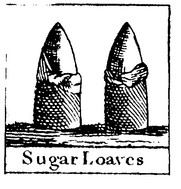 It is thought that the early French-Canadian fur traders named the mountain at the turn of the 17th century. The landform resembled the way blocks of sugar, in conical form, were being sold in Europe and also packed for sea voyage. They consisted of the top representing the clumped sugar peeking out from a green or brown paper wrapper. Two of our area’s first European explorers were Franz Ludwig Michel and Baron Christoph Von Graffenried. Both were from Switzerland and had the opportunity to climb the monadnock in the first decade of the 1700’s. In his diary, Graffenried claims that the traders call the mountain “pain du sucre.” He likely learned this from his guide up the mountain, a reknown French Canadian fur trader named Martin Chartier. Chartier was married to a Shawnee woman, had a large contingent of Shawnee followers and operated a trading post at the mouth of the Monocacy around 1712-13. Just for trivial effect, I will share that one of the most famous monadnocks in America is Pilot Mountain, located in Surrey County, North Carolina. It is located near Mt. Airy, the real hometown of television legend Andy Griffith. Now for the Andy Griffith television show of the 1960’S, Sherriff Andy Taylor lived in Mayberry (a play on Mt. Airy). The neighboring town (on the show) was Mount Pilot, which takes its inspiration from Pilot Mountain. And as far as Sugarloaf mountains, we are not alone. They exist in several states: Michigan, Maine, Massachusetts and New York, along with other countries—Ireland, Australia, Canada and Japan. However, the most famous Sugarloaf Mountain of them all is located in Rio de Janiero (Brazil).
This past Saturday, my youngest sons and I made a pilgrimage to Cunningham Falls State Park for the annual Maple Syrup Demonstration. This was the 46th edition of the popular event which is held in, and around, the Houck Lake Area of the park. For my youngest son Eddie and I, it’s been an annual rite of Spring as this was our 9th consecutive visit (he’s been going since age 1). In recent years, we have had the opportunity to share this tradition with my stepsons (Eddie’s stepbrothers). One of which, Vinnie made the sojourn this year. 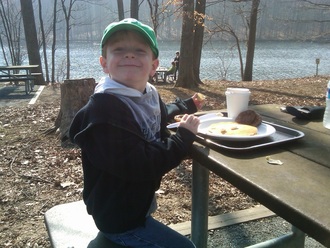 The magic of pancakes with plenty of maple syrup! The magic of pancakes with plenty of maple syrup! The “Maple Syrup” event is always a great Frederick County experience, and you never know what the March weather will hold be it lamb, lion or something in between. An ode to maple syrup in a great natural, park setting seems to attract plenty of folks each year (and from out of the Frederick area as well): south central Pennsylvania, the panhandle of West Virginia, Washington, Carroll and Montgomery counties (Maryland), DC and Northern Virginia. How can things be bad when you can start off your visit with a pancake breakfast—a perfect sampling experience for Maryland-made maple syrup. That’s right Vermont….so back off! The festival occurs over two weekends in mid -March and features “maple syrup boiling” demonstrations and family entertainment and crafts. For us, and many others, the trip is always capped with a short hike up to the namesake Cunningham Falls. To both young and old, this is quite an accomplishment, especially in respect to counteracting the effects that pancakes and syrup have on the human body.  The famed Cunningham Falls has intrigued me more and more each year, and not for the geologic reasons you would think. Cunningham Falls is not your typical waterfall like the legendary Niagara, Great Falls down the Potomac towards DC or Muddy Creek Falls out in Garrett County. Instead, ours is a cascading waterfall, and not just any cascading waterfall—it’s the largest cascade in the state. The other day, we walked to “the Falls” amidst a light snow—pretty amazing, since my boys had baseball practice just a few days prior with the temperature hovering in the 70’s. We had our customary picture taken for archival and “FaceBook” purposes. As we started making our way back off the boardwalk observation area, I heard another Dad proudly telling his family about the origin of the the Falls and its mysterious name. He said: “This used to be called McAfee Falls after the original owners of the land. Then the government took it away from them, and renamed it “Cunningham Falls.”  Hunting Creek Gap (aka Harman's Gap) Hunting Creek Gap (aka Harman's Gap) I just smiled walked by, not particularly in the mood to share a history lecture with this gentleman as he surely deserved a bit more of “rest of the story.” I had stumbled over a bit more, but not all, of the Cunningham Falls “name game” a few years back when I was researching and compiling a documentary on nearby Thurmont, entitled “Almost Blue Mountain City.” The story actually goes back to colonial times and the first Europeans in the area. Now thousands of years of native habitation likely included several other monikers for this geologic water form that we will never un-earth. In the mid 1700’s, German settlers were winding their way down into the Maryland colony from Pennsylvania via the aptly named German Monocacy Road. Some stayed and settled here, while others continued in a southwesterly fashion, heading into the Shenandoah Valley heading south. The romantic story of the immediate area says that the Weller family camped at Cold Spring because of a sick child. The child died, but the family decided to stay, making them the first European settlers of the area in 1751. Again, I’d like to insert the word “story” here because it is not the definitive way things happened, but that’s a blog for another day.  What is certain is that the “Great Road” west of (what would one day become) Thurmont crossed over, and through, Catoctin Mountain. Today this is Maryland route 77, also known as Foxville Road. Amidst the beautiful scenic views of trees, streams, rocks and “the cascading falls,” the sometimes treacherous and “zig-zagging” road is much improved compared to its rustic beginnings. All this is relative because this road, at the time, certainly made Colonial era travel possible over the large landform of Catoctin Mountain. Travelers, pioneers, businessmen and farmers used this transportation route regularly, and at least one person used it “religiously.” This was Graceham Moravian Church minister Samuel Reinke (1791-1875).  Grave of Rev. Samuel Reinke (1791-1875) in Moravian Cemetery, Bethlehem, PA. Grave of Rev. Samuel Reinke (1791-1875) in Moravian Cemetery, Bethlehem, PA. Reverend (and later Bishop) Reinke served the Graceham congregation from 1827-1835. During this time, the cascading waterform was the key “tourism highlight of the area.” It certainly was not called Cunningham Falls back then, rather it was known as Hermann’s (or Herman’s Falls) by the late 1700’s and early 1800’s. We know this based on a watercolor Reinke painted, dated 1828. Like me, Rev. Reinke likely brought his own young sons here to the falls as well. Ironically, his oldest was named Edwin just like mine, but I’m guessing the nickname “Eddie” wasn’t in vogue back then. Instead of a Vinnie, he had other sons named Amadeus and Clement. All three offspring would follow in their father’s life work as ministers, with Rev. Amadeus A. Reinke serving at Graceham’s faith leader from 1849-1854. The Hermann Family (anglicized to Harman) originally settled in the area in the 1770’s and owned the cascading waterfall depicted by Reinke in a watercolor painted in 1822. Original settler Marcus Hermann, Jr. was a descendant of Augustine Hermann, an early Maryland mapmaker and owner of Bohemia Manor in Cecil County. Marcus Hermann had purchased land from Leonard Moser, a 30-acre tract of property called “Nolin” or “Knoll-in” Mountain. Sometimes this has been referred to as Noland’s Mountain as well. Regardless, the Hermanns would also own the “Cold Spring” property to the east, and this gave birth to the origin of the name “Harman’s Gap.” Marcus’ children would eventually intermarry into the McAfee family by the late 1800’s and the falls would become known more commonly by another name, McAfee Falls. However, the McAfee family is said to have called the cascade ”Hunting Creek Falls.” The federal government in the 1930’s laid claim to much of the mountain land including that of the McAfees. After years of making charcoal (to fuel nearby iron furnaces), mountain farming, and harvesting of trees for timber, land was purchased by the federal government to be transformed into a productive recreation area, aimed at bringing land back to its original condition while providing meaningful employment for people during the Great Depression. Beginning in 1935, the Catoctin Recreational Demonstration Area went under construction by both the Works Progress Administration and the Civilian Conservation Corps. The northern portion of the park was transferred to the National Park Service in 1936, and renamed and reorganized in 1954. The 5,000 acres south of MD77 were transferred to Maryland, becoming Cunningham Falls State Park.  And this is where I continue to research and remain stuck. Supposedly, it was at this time in the 1950’s that the name of Cunningham Falls came about. However, I found an early 20th century postcard that refers to Cunningham’s Falls, but dates to 1908. In any case, I still have not been able to find the “Cunningham” namesake but have heard several possible sources. Some talk of an influential bureaucrat named Cunningham, but no first name or affiliation. Many sources says that Cunningham Falls was named for a photographer, from either Baltimore or nearby Pen Mar Park, who frequently took great pleasure in photographing the falls. Yet, other leads I have been given over time point to a Judge B.A. Cunningham from Frederick, and a Dr. Cunningham from Hagerstown. I give up, and simply like the monikers of Hemann’s Falls or McAfee Falls because we at least know who they were! We may never know the true namesake of Cunningham Falls, but are truly fortunate to have such natural beauty and recreation opportunity here in Frederick County. My boys, however, at this stage of their lives, are more grateful for pancakes and syrup. Of course, I realized this as both Eddie and Vinnie dozed off in the back seat while I was telling them the confusing namesake story of the falls on the way back home after our visit.
|
AuthorChris Haugh Archives
February 2024
Categories |
Proudly powered by Weebly







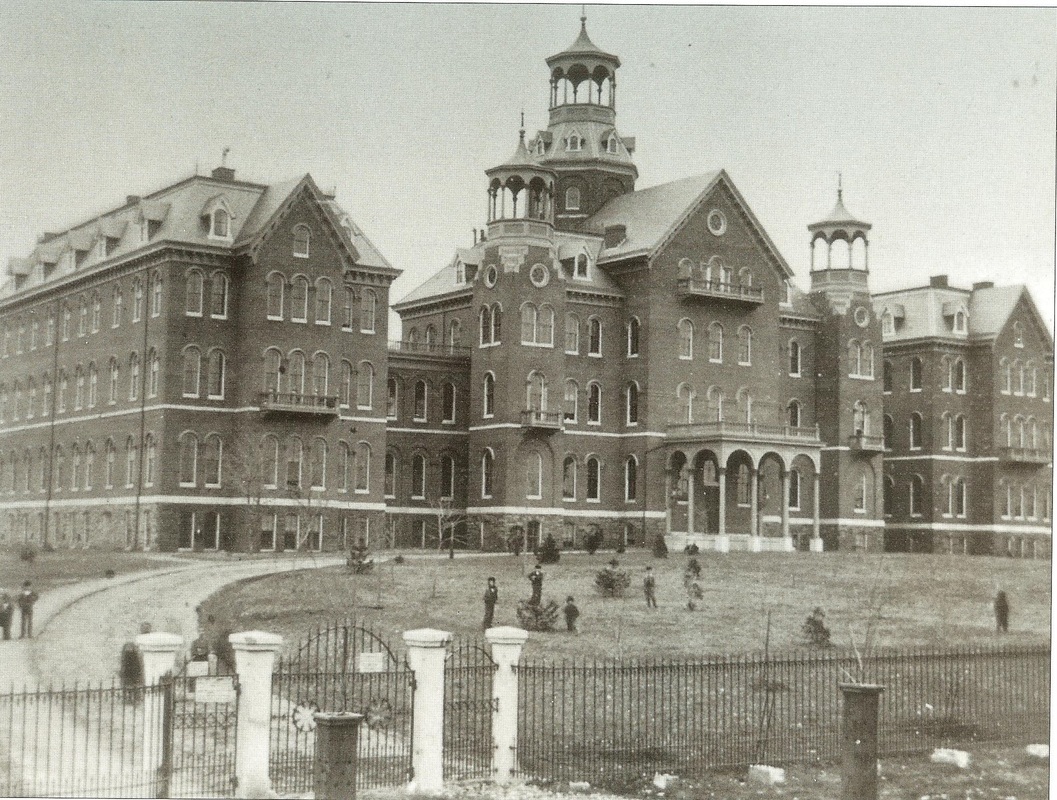



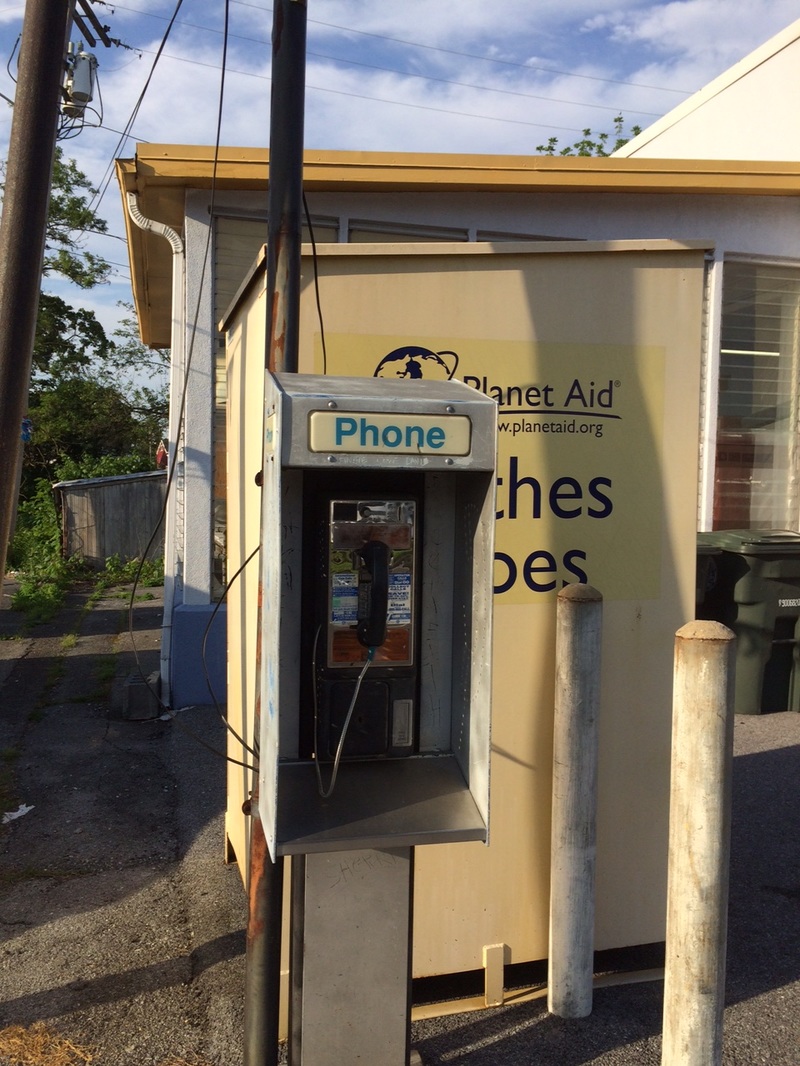



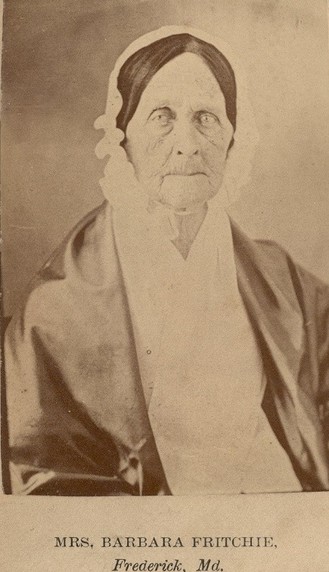




































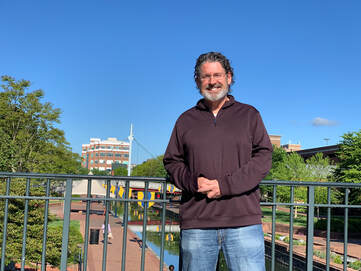







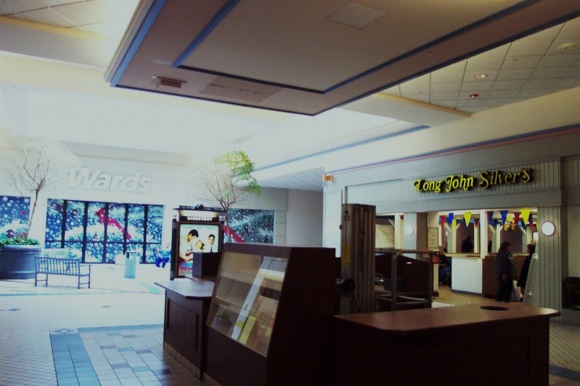

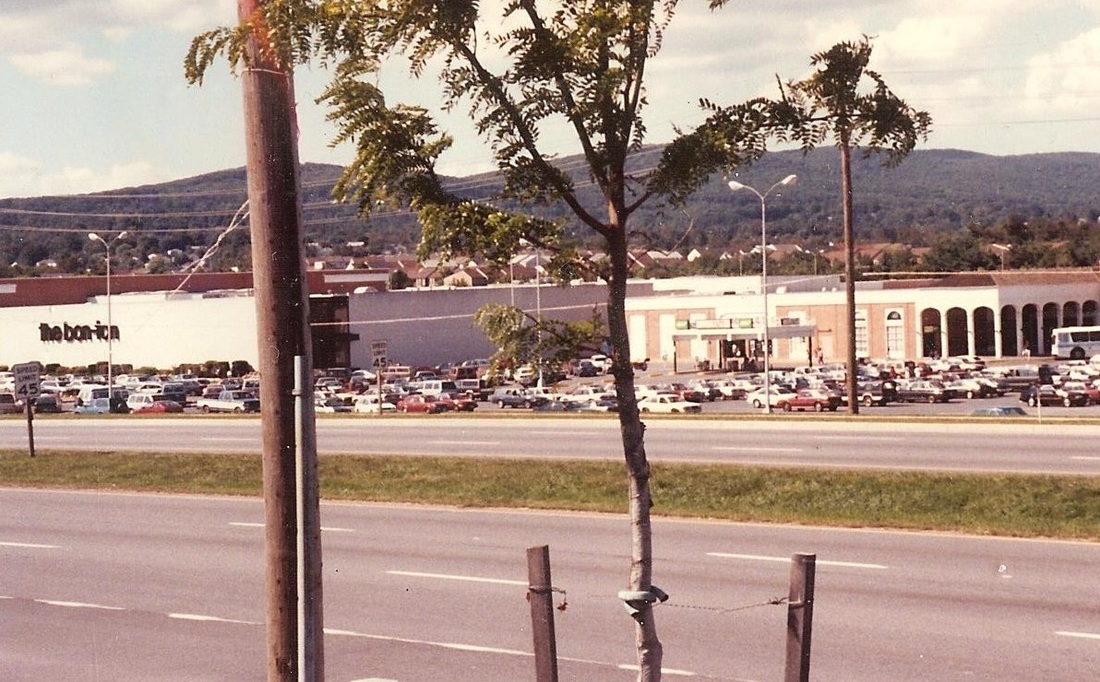

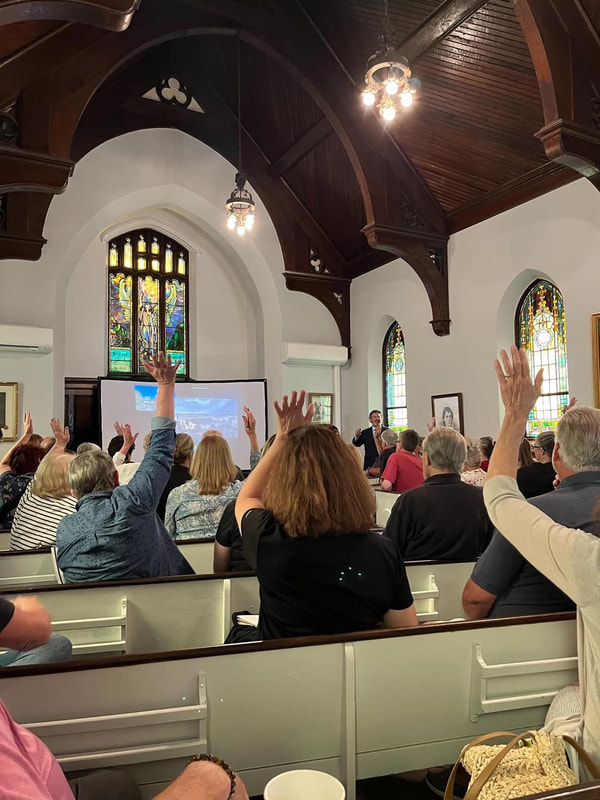





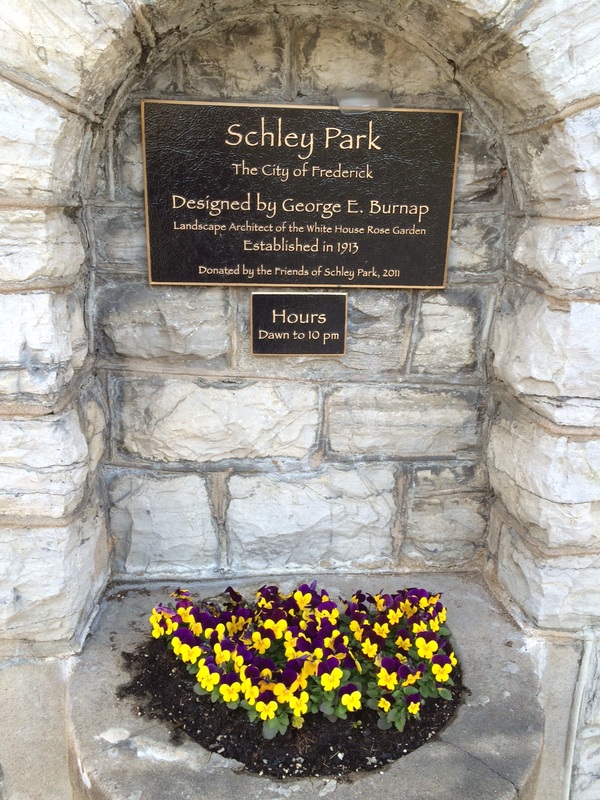


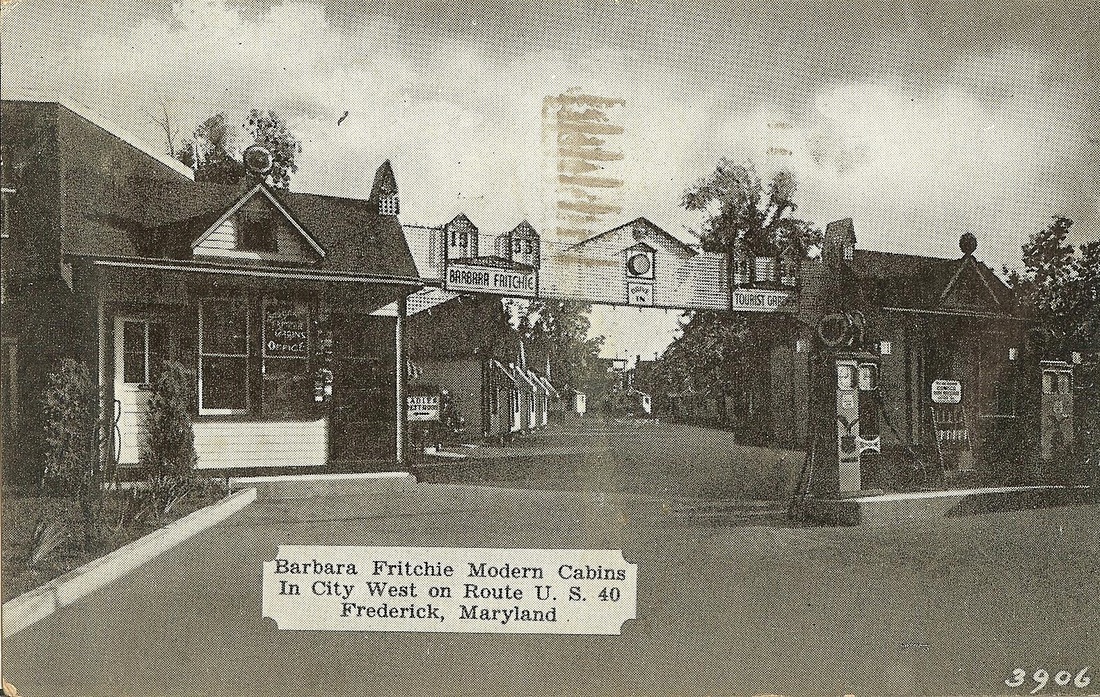








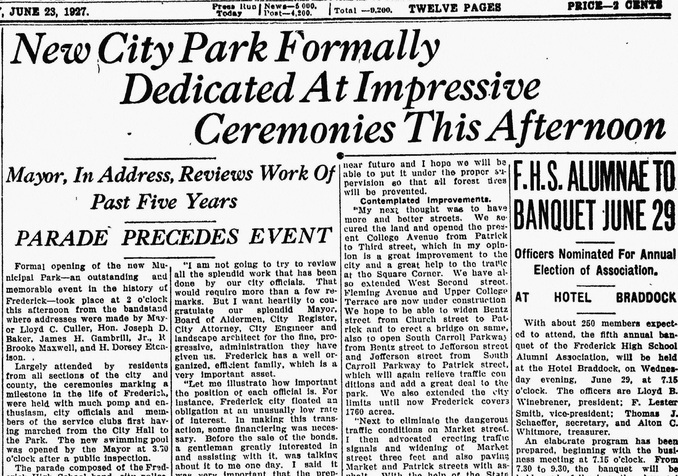


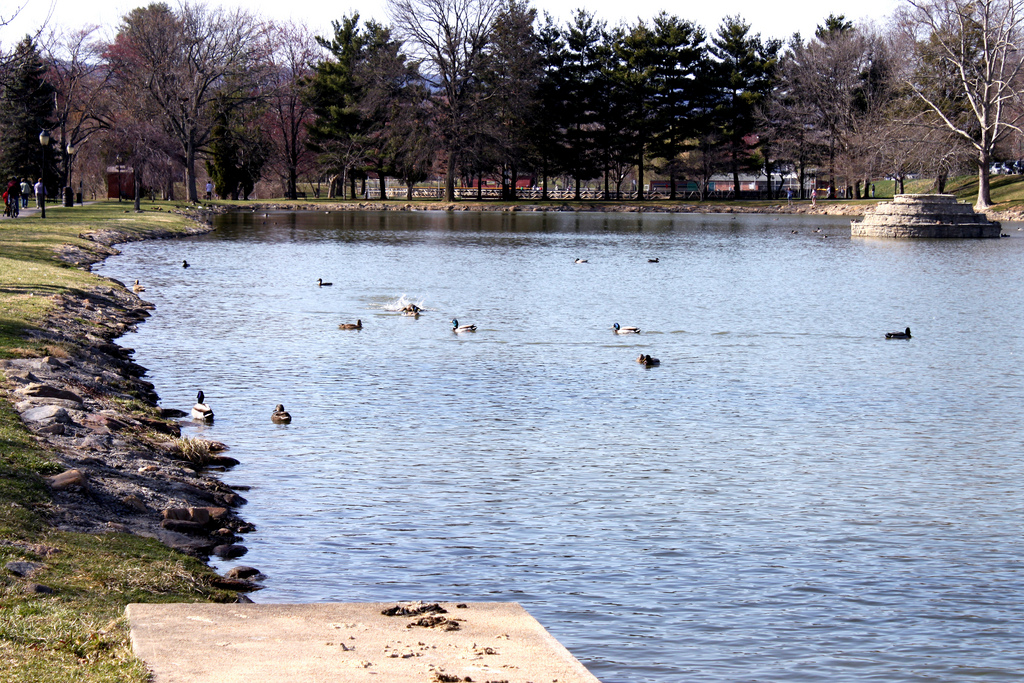





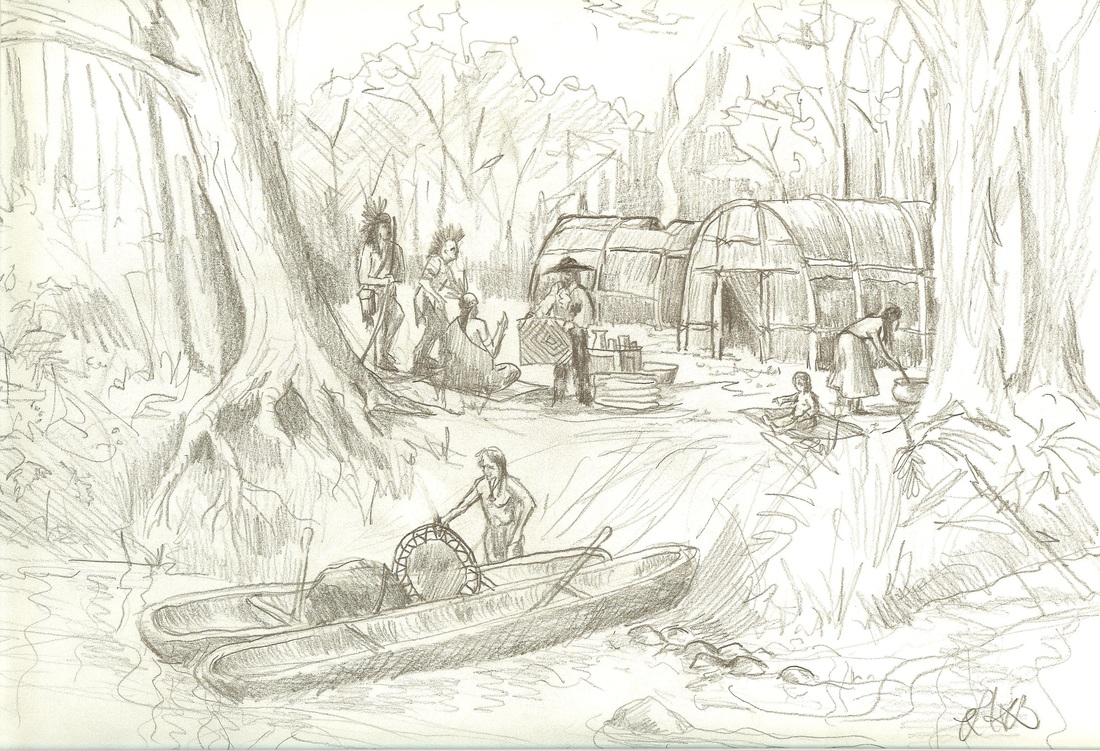
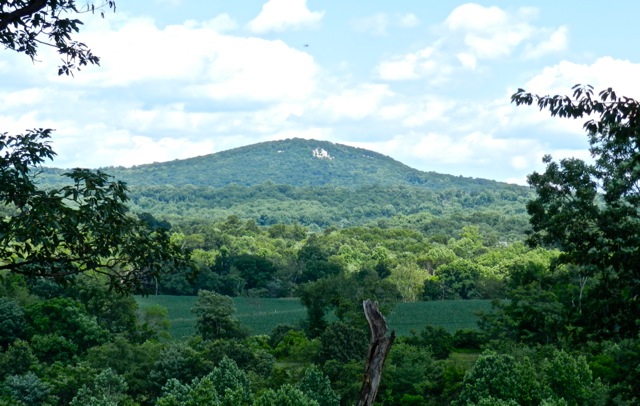












 RSS Feed
RSS Feed